Here's a recap of our trip to Lisbon, Portugal! People keep asking me, "Why Lisbon?" Because Rick Steves has a book about it, that's why :) Warning - it's filled to the brim with photos... I'm talkin' almost 130 pics/collages - you try going to Lisbon and not take photos every few feet, I dare ya!
So, Saturday morning we finished packing (note to self: don't forget to bring more than 1 pair of pants on our next trip...), loaded up, and drove to Munich. There are ZERO, I repeat, ZERO(!!!) stoplights between our house and the airport. Isn't that just crazy??? In California there were 33 stoplights between our apartment and my secretarial job I had briefly. We live in the middle of nowhere. No stoplights needed. And I love it. Anyway, we passed cute village after cute village - this is Nabburg. Someday we'll actually go there and walk around it.
So, Saturday morning we finished packing (note to self: don't forget to bring more than 1 pair of pants on our next trip...), loaded up, and drove to Munich. There are ZERO, I repeat, ZERO(!!!) stoplights between our house and the airport. Isn't that just crazy??? In California there were 33 stoplights between our apartment and my secretarial job I had briefly. We live in the middle of nowhere. No stoplights needed. And I love it. Anyway, we passed cute village after cute village - this is Nabburg. Someday we'll actually go there and walk around it.
We arrived at the Munich airport and parked the car in an off-site lot.
Then we made our way to the train station.
Waiting for the train. It was sunny. And warm. Perfect weather.
We had a little hiccup at the check in counter trying to get Chris his boarding pass (they couldn't find his reservation...) but a few phone calls later and we were good to go, got through security, found our gate, and ate some lunch.

When we boarded the plane the captain came on and gave his spiel then said the flight time was 3 hours. I didn't realize there was a time change and had only mentally prepared myself for 2 hours! That was a low blow. But what can you do? Thank goodness for iPads! And it actually ended up being 3.5 hours, who knows why. Bad weather or headwinds or something. On the 2nd picture below I was trying to capture the snowy Alps and the second I pressed the shutter button another airplane flew right under us!

Fox got tired and rested on my lap. Meanwhile Jane was not the happiest of campers.

We landed, found all our luggage, then stood in line at the Tourist Information hub to purchase the Lisboa Card - this card covers all public transportation (as well as trains to Sintra and Cascais) and free entry to many museums and discounts at lots of sights. Definitely worth the savings! Then we took a hair-raising taxi ride to the apartment I found on airbnb - Mouraria Living in Lisbon City for 70 euros a night. It might not look like much on the outside, and the neighborhood is super sketch, but...

When we boarded the plane the captain came on and gave his spiel then said the flight time was 3 hours. I didn't realize there was a time change and had only mentally prepared myself for 2 hours! That was a low blow. But what can you do? Thank goodness for iPads! And it actually ended up being 3.5 hours, who knows why. Bad weather or headwinds or something. On the 2nd picture below I was trying to capture the snowy Alps and the second I pressed the shutter button another airplane flew right under us!

Fox got tired and rested on my lap. Meanwhile Jane was not the happiest of campers.

We landed, found all our luggage, then stood in line at the Tourist Information hub to purchase the Lisboa Card - this card covers all public transportation (as well as trains to Sintra and Cascais) and free entry to many museums and discounts at lots of sights. Definitely worth the savings! Then we took a hair-raising taxi ride to the apartment I found on airbnb - Mouraria Living in Lisbon City for 70 euros a night. It might not look like much on the outside, and the neighborhood is super sketch, but...
the inside is probably the nicest place we've stayed at as far as decor and finishings! So fancy!


Two bedrooms, a little kitchen, nice living room, free wifi, updated bathroom, laundry machine, etc.


I totally want my future house to look like this apartment. Loved everything about it.
And the VIEW!!!!! Holy moly! Totally worth every penny.
By the time we got to the apartment and settled in it was dinner time and darkness was quickly approaching. We cooked some pasta, showered the kids, put them to bed, then watched a movie (Angus, Thongs, and Perfect Snogging, if you're curious :).
The next morning we woke up to a beautiful rainbow. I mean, really, how picturesque and perfect!
The next morning we woke up to a beautiful rainbow. I mean, really, how picturesque and perfect!

I have no idea what happened, but I am SOOOOO HAPPY and GRATEFUL that my camera didn't break. Definitely said a prayer of thanks.

Charming, charming!






The statue is of King José I - the man who gave control of the government to Pombal who rebuilt the city after the quake. Built 20 years after the quake, it shows the king on his horse with Pombal looking at their port.
This big arch marking the inland side of the square is Lisbon's Arch of Triumph.


At this point, rather than continue on the walk, we decided to head out to Belém for reasons I can't remember so we found a bus stop.
We passed right under the 25th of April Bridge. Very cool.
The details of the monastery are immaculate.





After the church we waited in the long line and purchased tickets to the cloisters.

The 170-foot concrete structure shows that exploring the world was a team effort. The men who braved the unknown stand on the pointed, raised prow of a caravel, about to be launched into the Rio Tejo.
For €3 I took an elevator up to the top for amazing views of Belém.


At the top of the Monument to the Discoveries, looking at the Golden Gate Bridge, I mean, 25th of April Bridge, and the Christ the Redemeer, I mean, Christ Rei.
It was quite squishy up at the top and I had to squeeze my way through to get photos. Gotta do what you gotta do!
Then we walked to the Belém Tower, passing a colorful boat dock on the way.

We didn't go in or up, the view of it was beautiful enough!
We walked by the Casa Pastéis de Belém café - the birthplace of the wonderful custard tart called pastel de nata. Since 1837 residents have come to this café to get their tarts warm out of the oven. This place's popularity (check out that queue of people!) stems mainly from the fact that their recipe is a closely guarded secret - supposedly only three people know the exact proportions of ingredients.
And that was Belém in a nutshell! We took the bus back to where we had left off with our morning walk and continued on.
We could see the Cathedral Sé and attempted to walk to it, but for the life of us we couldn't figure out which street took us there so we gave up. Kind of looks like Notre Dame from afar. Yes? No? Maybe?
After the disastrous 1755 earthquake the Baixa district (the flat valley between two hills) was rebuilt on a grid street plan. The uniform and utilitarian Pombaline architecture (named after the Marquês de Pombal, the prime minister who rebuilt the city) feels almost military. That's because it is. The Baixa was built by military engineers who had experience building garrison towns overseas. The buildings are all uniform with the same number of floors and standard facades.
Tiled buildings are my favorite.
Can't. Stop. Taking. Pictures.
Given its elongated shape, historians believe the Rossio was a Roman racetrack 2000 years ago; these days, cars can circle the loop instead of chariots.
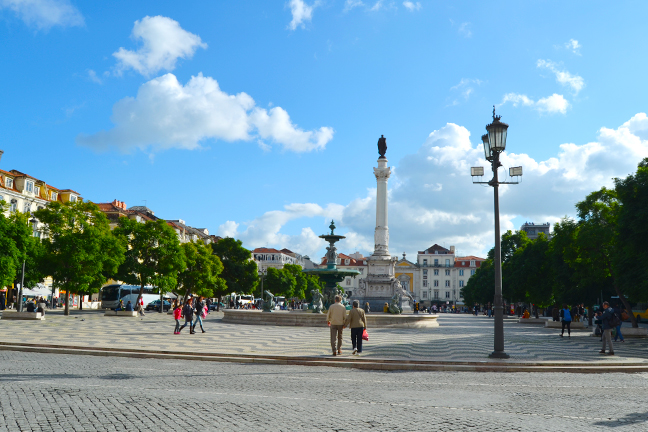
We walked a little further to another square - the Praça dos Restauradores.

So glad we didn't have to walk up this steeeeeep hill! Another way Lisbon is similar to San Fran - all the hills.

This tile map guides you through the view. Here's Chris studying the map.
In the park a bust honors a 19th-century local journalist (founder of Lisbon's first daily newspaper) and a barefooted delivery boy. This district is famous for its writers, poets, publishers, and bohemians.


Love this door and windows.
Fox visited the statue of a friendly lottery ticket salesman and rubbed the ticket for good luck.
Sick of tiles yet? Sorry, there's lots more :)
Check out this display - tubes stuffed with thread that kind of look like marbled rods! Very anthro-like.


We called it a day at that point and headed home. Here's Janey on the metro back to the apartment. She looks beat :)
We made spaghetti again for dinner then settled in for the night, happy after a long and wonderful day!
On Monday we took a day trip to Sintra - that'll be my next post so stay tuned.
On Tuesday we woke up bright and early to try and pack in all of the things we missed.
Heading uphill towards the São Jorge Castle.
This area is called the Alfama - the colorful sailors' quarter that dates back to the age of Visigoth occupation, from the sixth to the eighth centuries AD. This was a bustling district during the Moorish period and eventually became the home of Lisbon's fisherman and mariners. The Alfama's tangled street plan is one of the few features of Lisbon to survive the 1755 earthquake. It helps make the neighborhood a cobbled playground of Old World color. 
At the Largo Santa Luzia square we admired the panoramic view from the small terrace.





Then we took the funicular back up the super steep hill.


The acoustics here are top-notch, important in a Jesuit church where the emphasis is on the sermon.


Continuing on our walk.

Red door entrance to the Convento do Carmo. We had wanted to visit this when we were in this part of town on Sunday, but it was closed. Thankfully, we were able to squeeze it in on Tuesday.
Inscription engraved next to the entrance.

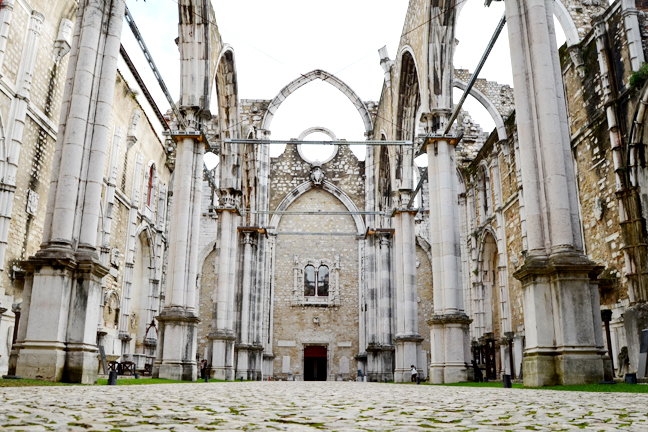


Bye bye Lisbon, until we meet again!
























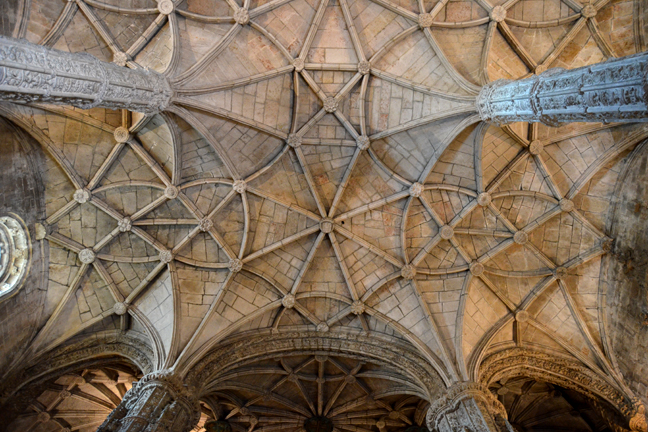


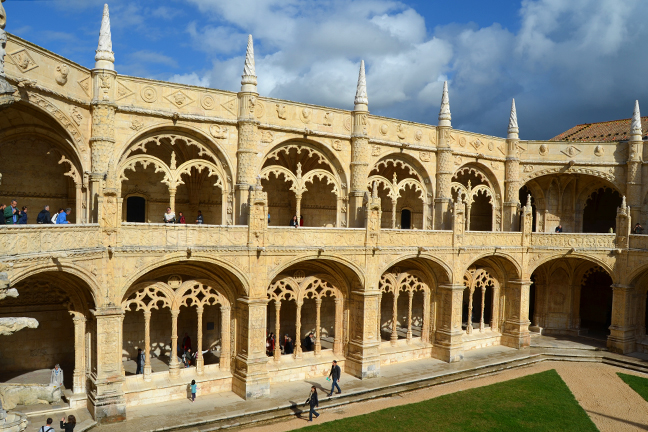




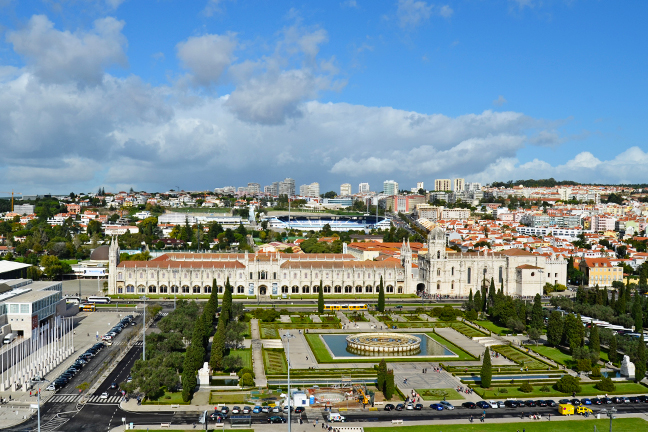












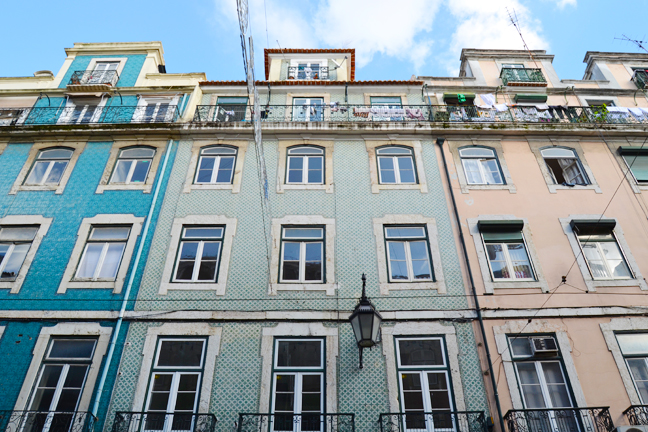





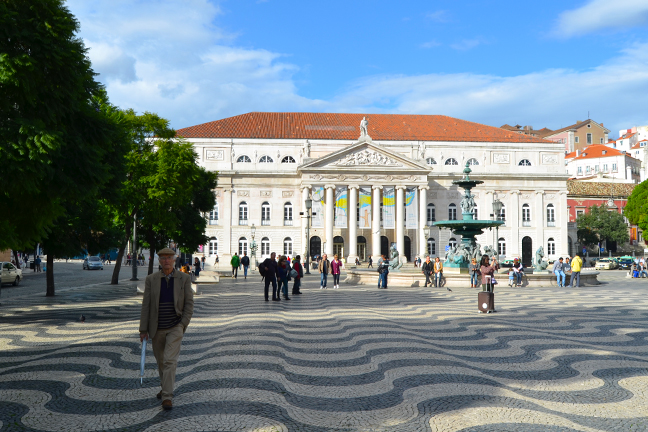







































I love the tile buildings and colorful homes. Who'd have thought Lisbon would have been so pretty and enjoyable? FUN! And I'm so glad your camera didn't die. You lucked out there!
ReplyDeleteHow fun! LOVING all the photos!!! Glad your camera is ok!!!!!
ReplyDeleteI was pleasantly surprised by Lisbon, as well. Very photogenic city. Our apartment was very nice, great choice!
ReplyDeleteSo many pictures, but definitely worth it! Thank goodness your camera started working again!! Who knew Lisbon was so pretty!!!
ReplyDeleteHow do you remember all the little details from your travels!? Gorgeous pics, thank you for the awesome history too.
ReplyDeleteThank you so much for learning all of this about our country history! I'm glad you're camera didn't broke you took so many beautiful photographs.
ReplyDeleteI hope you liked the Pastel de Nata, it's my favorite cake, with cinnamon it's even better!!